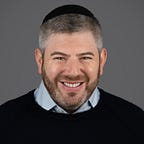Every One of Them Still Needs Every One of Us
Several weeks ago, Natan Sharansky, the refusnik who became the face of oppressed Soviet Jews, is a modern-day Jewish hero, spoke to 800 guests on a wintery Sunday night at Congregation Kehilath Jeshurun in New York City. He was joined by his dear friend, Rabbi Haskel Lookstein, KJ’s esteemed rabbi emeritus and a recognized leader of Modern American Orthodoxy.
The sanctuary buzzed with excitement as these pillars of modern Judiasm discussed the most socially significant issues of our time: rising antisemitism, the power of Jewish identity and the threat to America’s democratic institutions. It was a conversation I will remember for my lifetime.
Sharansky spent almost ten years in a Soviet gulag. He was freed on February 11, 1986. How can we imagine the mental and physical anguish that he experienced? The brutality of his captivity? The interminable days and nights of deprivation that were designed to punish a man of conscience?
For the members of Congregation Kehilath Jeshurun and the Ramaz School, Sharansky’s story was not only familiar but also personal: during the 1970s, countless members of the KJ community marched and protested on behalf of Soviet Jewry.
Sharansky is currently chairman of the Institute for the Study of Global Antisemitism and Policy. He also served as a minister in two Israeli governments and spent 10 years as chairman of the Jewish Agency for Israel. He told us that he might have been freed sooner had he capitulated with his captors. But he refused. The movement was greater than his personal sacrifice, he said.
What a lesson this is: Don’t stand for your principles. Live for them.
He sat with Rabbi Lookstein on the bima in front of the Ark from where we draw our moral and spiritual inspiration. Two vintage posters from the ’70s hung over them.
Over the faces of imprisoned Soviet Jews, including Sharansky’s, one of the posters said: “Every one of them needs every one of us.”
Rabbi Lookstein pointed to a space near the Ark where a solitary chair was left empty during the High Holidays as a visual reminder that Soviet Jews were forbidden to practice their religion.
But Sharansky never doubted his trust in God. This was also evident as he discussed the strength of his marriage to his wife, Avital. During her husband’s captivity, Avital had become an observant Jew who took on Torah and mitzvot. At the time, the Israeli press speculated whether their relationship would survive. Would Sharansky become dati? Would forgo some of her religious observances? Would they separate?
“You have to start with one mitzvah.” Sharansky said. “I took on one mitzvah, shalom bayit — and we took it from there.”
God has now blessed their remarkable union for 48 years.
When the pioneering Soviet Jewry activist Malcolm Hoenlein joined the men on the bima, the conversation took on a new urgency.
“Let’s call antisemitism what it is,” said Hoenlein, the executive vice chairman of the Conference of Presidents of Major American Jewish Organizations who also served as the first director of the Greater New York Conference on Soviet Jewry in the early 1970s.
“It is Jew hatred.”
Now is the time, Hoenlein said, “to start a mass movement to combat Jew hatred wherever we find it, anywhere in the world. We must call it out for what it is. We must stand tall as Jews everywhere we go.”
My wife and I watched our four children process the exchange between the greatest living symbol of the struggle for Soviet Jewry and an American Rabbinical treasure. These men were carrying a profound message to a new generation: that courageous souls are fighting for our religious freedom every day.
The call to action was clear. The battle for our religious freedom is real. And we go to war whenever it is challenged.
The struggle continues.
